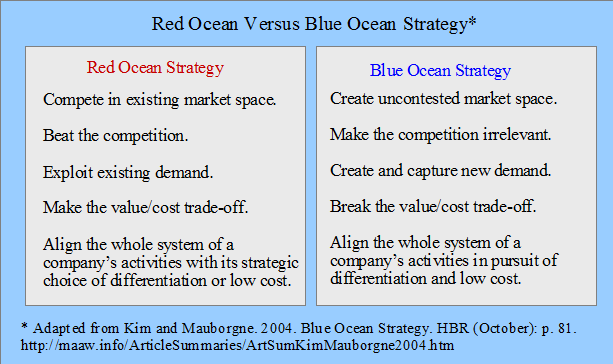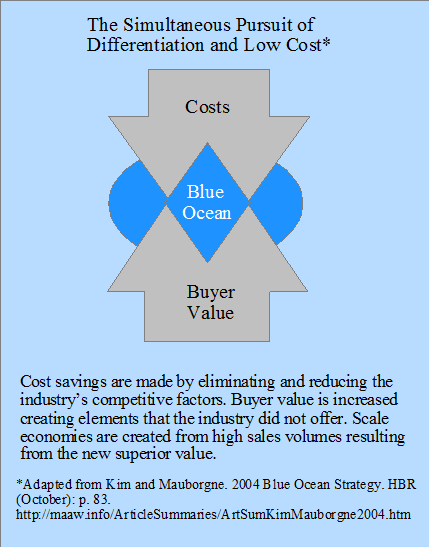
Summary by James R. Martin, Ph.D., CMA
Professor Emeritus, University of South Florida
Change and Risk Management Main Page |
Strategy Related Main Page
Kim and Mauborgne begin with a discussion of Cirque du Soleil, a company founded in 1984 with the tagline "We reinvent the circus." Cirque created new uncontested market space that made the competition irrelevant. According to Kim and Mauborgne, the business universe consist of two very different kinds of space, red oceans and blue oceans. Red oceans are all the industries currently in existence where boundaries are defined and accepted. Blue oceans are all the industries not currently in existence where demand in created, not fought over. Blue oceans can be created as new industries, but are more often created by altering the boundaries of an existing industry. Over the past 100 years, more than 150 blue oceans have been created in over 30 industries, usually with a consistent pattern of strategic thinking. The purpose of this paper is to present the concept of blue ocean strategy and to describe its characteristics.
Blue and Red Oceans
So many new industries had been created over the past 100 years that the Standard Industrial Classification (SIC) system established in 1937 was replaced by the North American Industry Classification System (NAICS) in 1997. The new system expanded the ten SIC industry sectors to twenty to reflect the many new blue ocean industries. In current overcrowded red ocean industries, supply is overtaking demand and differentiating brands is becoming more and more difficult. Blue oceans are and will remain the engine of growth.
The Paradox of Strategy
In a study of 108 new business ventures, 86% were line extensions of existing offerings, while only 14% percent created new markets or industries. However, the ventures into new markets or industries generated 38% of the total revenue and 61% of the profits. The differences in the red and blue ocean strategies helps reveal the differences in profitability. A red ocean strategy means accepting the constraints of a crowded industry, and the need to beat your competitor to succeed. A blue ocean strategy, on the other hand means doing business where there is no competitor. Perhaps most companies have focused on a red ocean strategy in recent years because corporate strategy has been influenced by military strategy and global competition has significantly increased. Kim and Mauborgne refer to this as the competitive-advantage worldview, but focusing on competition ignores the more lucrative aspects of strategy, i.e., finding or developing markets where there is no competition, and exploiting and protecting them.
Toward Blue Ocean Strategy
Kim and Mauborgne provide a table showing 13 companies that represent examples of key blue ocean creations drawn from their study of over 100 years of data. Examples include Ford's 1908 Model T, GM's 1924 car for every purse and purpose, Japanese 1970's fuel-efficient autos, Chrysler's 1984 minivan, CTR's 1914 tabulating machine, IBM's 1952 650 electronic computer and system/360, Apple's 1978 personal computer, Compaq's 1992 PC servers, Dell's 1990s build-to-order computers, the 1905 Nickelodeon (short films for 5 cents), Palace theaters 1914, AMC 1960s multiplex theaters, and AMC 1995 megaplex theaters.
They found a pattern of strategic thinking as follows:
1. Blue oceans are not about technology innovation - Blue oceans come from linking technology to what buyers value, e.g., Ford's assembly line can be traced back to the technology used in the meat-packing industry.
2. Incumbents often create blue oceans and usually within their core businesses - Most blue oceans are created from within an existing industry.
3. Company and industry are the wrong units of analysis - The strategic move, or set of management decisions and actions involved in creating a major market is the most appropriate unit of analysis.
4. Creating blue oceans builds brands - A blue ocean strategic move can create brand equity that last for decades.
The Defining Characteristics
There are a number of common characteristics of blue ocean strategic moves as indicated in the illustration below.

A blue ocean strategic move doesn't benchmark the competition. Instead, it makes the competition irrelevant by creating new market space. Blue ocean strategy rejects the trade-off between value and cost and pursues differentiation and low cost simultaneously. For example, Cirque du Soleil didn't follow the red ocean logic of offering a better solution to a given problem, i.e., creating a circus with more fun and thrills. Instead, Cirque offered the fun of a circus with the artistic richness of the theater. They dropped the high cost animal acts, kept the clowns, tent, and acrobatics, and offered multiple productions based on different themes, music, and story lines. By combining circus and theater, Cirque achieved both differentiation and low costs.
Rejecting the trade-off between low cost and differentiation represents a fundamental change in strategic thinking from a structuralist view where market boundaries and industries are set, to a reconstructionist view where the market boundaries and industries can be reconstructed to create entirely new uncontested market space.

Barriers to Imitation
A blue ocean strategy creates a number of economic and cognitive barriers to imitation. For example, a blue ocean business model attracts new customers in large numbers to provide economies of scale that protect the new market space. In addition, organization politics tends to obstruct the ability of potential competitors from switching to the new blue ocean model, and in some cases the new model may conflict with the imitator's brand image.
A Consistent Pattern
Blue oceans have always existed and the examples presented in this article show a consistent strategic pattern. Comparing Cirque du Soleil's theater-circus and Ford's Model T illustrates the pattern. Around 1900, luxury automobiles were handmade by 500 companies and sold for about $1,500. Ford reconstructed the industry boundaries of automobiles and horse-drawn carriages and created the Model T, the car "for the multitude" at an original price of $850, dropped to $609 in 1909 and $290 by 1924. Ford created the lowest cost structure by producing a standardized product with interchangeable parts on an assembly line, replacing the skilled craftsmen with unskilled laborers who each worked on one small task. The assembly line model allowed Ford to reduce the time required to make a car from 21 to 4 days. Ford, like Cirque made the competition irrelevant.
Companies need to understand the strategic logic of both types of oceans. Although red ocean strategy is currently the dominant strategy in theory and practice, the need for more blue ocean strategy intensifies. The real opportunity for sustaining high performance is to create blue oceans of uncontested market space. As indicated above, blue oceans are and will remain the engine of growth.
________________________________________
Related summaries:
Gadiesh, O. and J. L. Gilbert. 2001. Transforming corner-office strategy into frontline action. Harvard Business Review (May): 72-79. (Summary).
Johnson, M. W., C. M. Christensen and H. Kagermann. 2008. Reinventing your business model. Harvard Business Review (December): 50-59. (Summary).
Kim, W. C. and R. Mauborgne. 1997. Value innovation: The strategic logic of high growth. Harvard Business Review (January-February: 103-112. (Summary).
Kim, W. C. and R. Mauborgne. 1999. Creating new market space: A systematic approach to value innovation can help companies break free from the competitive pack. Harvard Business Review (January-February): 83-93. (Summary).
Kim, W. C. and R. Mauborgne. 2002. Charting your company's future. Harvard Business Review (June): 77-83. (Summary).
Kim, W. C. and R. Mauborgne. 2009. How strategy shapes structure. Harvard Business Review (September): 72-80. (Summary).
Kim, W. C. and R. Mauborgne. 2015. Red ocean traps: The mental models that undermine market-creating strategies. Harvard Business Review (March): 68-73. (Summary).
Magretta, J. 2002. Why business models matter. Harvard Business Review (May): 86-92. Explains the difference between a business model and a competitive strategy. (Summary).
Porter, M. E. 1980. Competitive Strategy: Techniques for Analyzing Industries and Competitors. The Free Press. (Summary).
Porter, M. E. 1987. From competitive advantage to corporate strategy. Harvard Business Review (May-June): 43-59. (Summary).
Porter, M. E. 1996. What is a strategy? Harvard Business Review (November-December): 61-78. (Summary).
Porter, M. E. 2001. Strategy and the internet. Harvard Business Review (March): 63-78. (Summary).